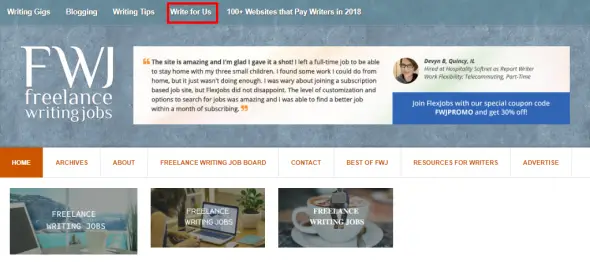You’ve heard of people who ditched their corporate posts to do freelance work. And now you’ve decided to join them and become a freelance writer. You read advice on how to start but you find yourself getting confused. You search for jobs on online job boards. But competition is stiff. What’s more, most clients ask for a portfolio, which you don’t have.
It’s not enough reason to give up and go back to that drudgery of a job. Instead of quitting before you have even started, you can build a portfolio website.
If you haven’t decided on a niche, you can write about several different topics. Write about topics you’re knowledgeable about and you want to get paid for. Examples of these are health and fitness, parenting, finance, technology, gaming or pets. You can also work on content types that your target clients may look for – sample newsletters and press releases, copywrites, and grant proposals.
If you aim to be a professional writer, you must have a professional-looking website. If the prospect sounds daunting, you can use free website hosting services that include a free website builder, and you’ll have a site that looks like it was done by a professional.
Filling up your portfolio website with content takes time, but its importance cannot be emphasized enough. One way to build your freelance writing portfolio is through guest blogging.
Guest blogging is an effective marketing tool to sell your services as a freelance writer. just follow the guide below.
A step-by-step approach to building a freelance writing portfolio through guest blogging
1. Look for blogs in your preferred niche
You can google using keywords and come up with a list of authority blogs. High authority blogs have a huge readership – the better to get your name known. You can check a blog’s domain authority using Ahrefs or Small SEO Tools.
Alternatively, get the names from Google’s ranked sites based on your search. Be wary of sponsored sites and vet each blog for trustworthiness.
2. Determine if your chosen blogs accept guest posts
Blogs that accept guest posts usually have a “Write for us” or “Guest posting” link on their website. It may be in the header, footer, or sidebar, so make sure to check thoroughly.
Social media is another great way to find out if a blog is open to guest posts. Twitter has a search function that will show blogs that are accepting guest posts or are currently looking for writers. You can find them by searching for “guest post,” “write for us,” “guest blogger,” and similar phrases. You can also look up the blogs on LinkedIn and send a direct message to its content manager or editor asking about possibilities for guest blogging.
3. Read the guidelines before creating your pitch
Blogs have different guidelines and requirements. Make sure to read them in detail before making your pitch. They may include methods for submission (i.e., via Google Docs or an email attachment), writing style, post length, rules on links, etc.
It’s important to follow the stylebook used by the blog if they specify it. The most used are the AP Style, The Chicago Manual of Style, and the MLA Handbook. Some sites prefer certain dictionaries, too.
4. Make your pitch to guest blog
Read the content of the blogs you will pitch to in order to get an idea of their popular topics.
The basics of making a pitch: do your research and get the editor’s or content manager’s name. No editor wants to read an email addressed to “editor.” Proofread your pitch more than once for grammatical and spelling errors.
More tips: Include your title and subtitles or a brief outline of your post. Check the blog to see that your intended guest post isn’t already covered. Include links to your other works to showcase your ability and expertise. Make your pitch personal, and avoid using a generic template.
[bctt tweet=”A well-crafted pitch will tell the editor that you’re a professional, increasing your chances of getting accepted.” username=”freelancewj”]
A well-crafted pitch will tell the editor that you’re a professional, increasing your chances of getting accepted.
Don’t submit the same title and outline to two or more blogs. If they accept you, you can’t write a post for each using the same title.
5. Write your guest post
When writing your post, keep the target audience in mind. Unless the blog’s name is specific, such as BMW Blog or Café Mom, you may find it a challenge to determine the target audience. One clue is to read the readers’ comments on the other posts or how the regular writers address the audience. This will give you an idea of the demographics of the blog’s target market.
Fit your post with the tone and style of the other published content. Examine if they are written in an informal tone, with bits of humor, or if they are formal. Read the guidelines about links and follow them strictly. Write content that gives more unique information than what is generally available.
Make your guest blog easy for the editor to upload. Ask, and if it helps them, include basic HTML tags to format elements you are using, such as bold, italicized, links, etc. Include images and their attribution.
6. Compose your author bio
Your author bio is also your marketing tool. It should contain a link to your website, social media accounts, or third-party reviews. The essential elements of a good author bio are:
- information about your service
- contact info
- a bit of your personality.
Author bios are written in the third person, and include facts, not goals, and your experience or credentials as a writer. Three sentences should be enough.
7. Submit and promote
You’re all set. Send your final article, and share it with your network when published.
Build your online portfolio through guest blogging
The competitive landscape of the freelance market, coupled with the demand for portfolios, can create uncertainty. However, it’s crucial not to let these challenges deter you from pursuing your passion. Instead of giving up prematurely, the key is to build a robust portfolio website, which can serve as your professional showcase.
Whether you’re still deciding on your niche or honing your skills, your online portfolio website can showcase various topics. From health and fitness to technology or pets, select subjects you are both knowledgeable about and eager to be paid for. Additionally, diversify your content by including sample newsletters, press releases, copywriting, and grant proposals to cater to potential clients.
Filling your portfolio with content is a process that requires time and effort, but its significance cannot be overstated. One highly effective strategy to build your freelance writing portfolio is through guest blogging. By following this step-by-step guide, you can successfully navigate the world of guest blogging and establish your presence as a professional freelance writer.
Embrace the opportunities that guest blogging presents, and watch your freelance career flourish.



Leave a Reply